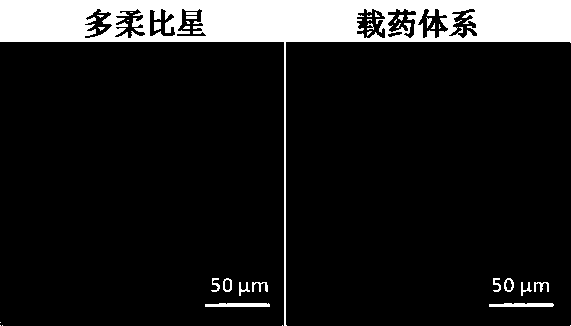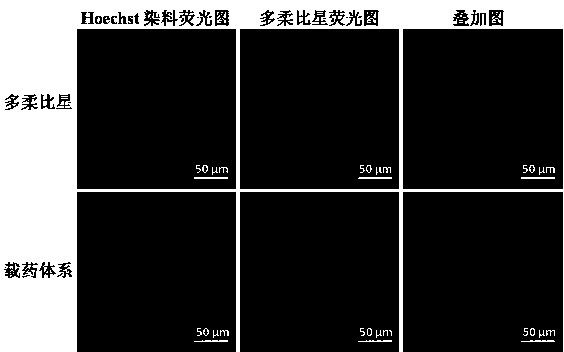Graphene quantum dot nuclear targeting medicine carrying system as well as preparation method and application thereof
A graphene quantum dot and drug-loading technology, which is applied in the field of biomedicine, can solve the problem that anticancer drugs cannot effectively accumulate in the nucleus, and achieve the effects of enhancing drug cytotoxicity, drug-loaded drug cytotoxicity, and increasing toxicity
- Summary
- Abstract
- Description
- Claims
- Application Information
AI Technical Summary
Problems solved by technology
Method used
Image
Examples
Embodiment 1
[0028] Example 1. Graphene Quantum Dot Targeted Drug Delivery System Loading Doxorubicin into Human Breast Cancer Cell MCF-7
[0029] 1. Cytotoxicity of the drug-loaded system:
[0030] The first step is to filter the 0.5 mg / mL graphene quantum dot aqueous solution and the 10 mM doxorubicin aqueous solution with a 0.22 μm filter membrane.
[0031] In the second step, the two reagents are shaken and mixed at room temperature to obtain a drug-loading system solution of doxorubicin with a final concentration of 10 μM and graphene quantum dots with increasing concentrations in turn.
[0032] Step 3: Inoculate MCF-7 cells on a 96-well cell culture plate at a density of 4,000-5,000 cells per well at 37°C, 5% CO 2 , after culturing for 12 hours under saturated humidity conditions to make it adhere to the wall, the medium was removed and washed with 0.1M PBS.
[0033] In the fourth step, 100 μL of drug-loading system solutions with different concentration ratios were added to the 96...
Embodiment 2
[0042] Example 2. Graphene Quantum Dot Targeted Drug Delivery System Loading Doxorubicin into Human Gastric Cancer Cell MGC-803
[0043] The first step is to filter the 0.5 mg / mL graphene quantum dot aqueous solution and the 10 mM doxorubicin aqueous solution with a 0.22 μm filter membrane.
[0044] In the second step, the two reagents are shaken and mixed at room temperature to obtain a drug-loading system solution of doxorubicin with a final concentration of 2 μM and graphene quantum dots with successively increasing concentrations.
[0045] Step 3: Inoculate MGC-803 cells on a 96-well cell culture plate at a density of 4000-5000 cells per well at 37°C, 5% CO 2 , after culturing for 12 hours under saturated humidity conditions to make it adhere to the wall, the medium was removed and washed with 0.1M PBS.
[0046] In the fourth step, 100 μL of drug-loading system solutions with different concentration ratios were added to the 96-well plate, and co-incubated with the cells f...
Embodiment 3
[0048] Example 3. Graphene Quantum Dot Targeted Drug Delivery System Loading Doxorubicin into Drug-resistant Human Breast Cancer Cell MCF-7 (MCF-7 / ADR)
[0049] The first step is to filter the 0.5 mg / mL graphene quantum dot aqueous solution and the 10 mM doxorubicin aqueous solution with a 0.22 μm filter membrane.
[0050] In the second step, the two reagents were shaken and mixed at room temperature for 30 minutes to obtain a drug-loading system solution of doxorubicin and 15 μg / mL graphene quantum dots with a final concentration of 1 μM, wherein doxorubicin and graphene quantum dots The concentration ratio is 1:15.
[0051] Step 3: Inoculate MCF-7 cells on 24-well cell culture plates with a density of 5×10 per well. 4 cells, among them, a Φ14mm gelatin-coated coverslip was placed in a 24-well plate in advance, and the cells were placed at 37°C, 5% CO 2 , after culturing for 12 hours under saturated humidity conditions to make it adhere to the wall, the medium was removed a...
PUM
 Login to View More
Login to View More Abstract
Description
Claims
Application Information
 Login to View More
Login to View More - R&D
- Intellectual Property
- Life Sciences
- Materials
- Tech Scout
- Unparalleled Data Quality
- Higher Quality Content
- 60% Fewer Hallucinations
Browse by: Latest US Patents, China's latest patents, Technical Efficacy Thesaurus, Application Domain, Technology Topic, Popular Technical Reports.
© 2025 PatSnap. All rights reserved.Legal|Privacy policy|Modern Slavery Act Transparency Statement|Sitemap|About US| Contact US: help@patsnap.com



